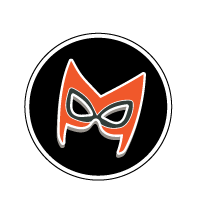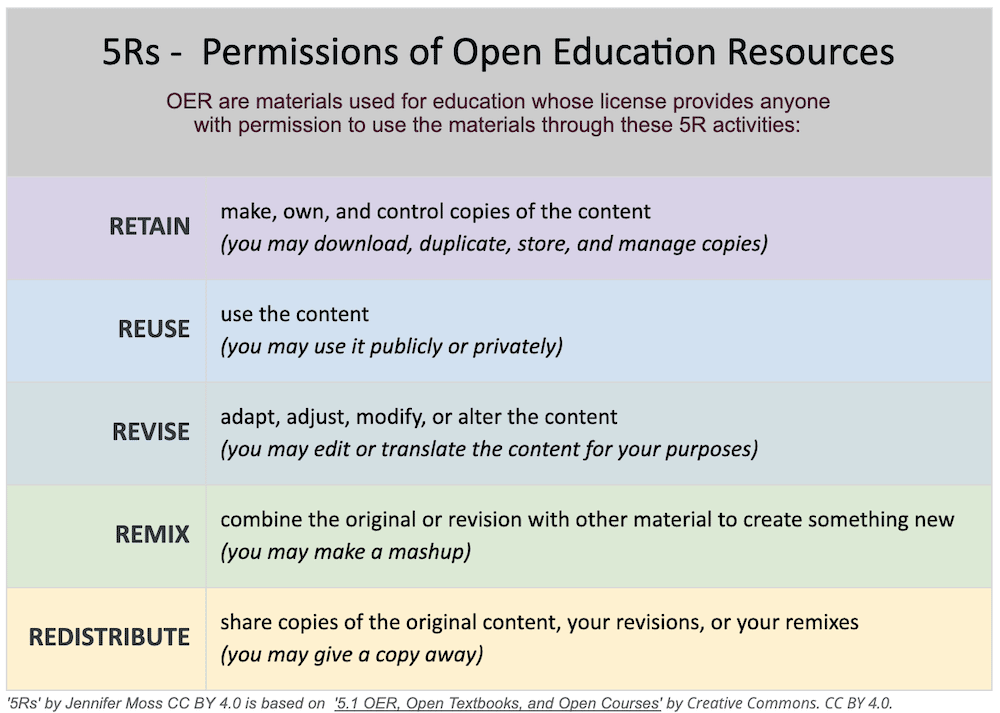What are OER?
 SUPERHERO GOALS
SUPERHERO GOALS
- read about and watch videos on Open Education and OER topics
- hear perspectives about OER from educators
- determine if a work is an OER based on the 5Rs
- contrast what is and is not an OER
Approximate time to complete: 30 minutes (15m read/watch; 15m activity)
Open Educational Resources (OER) are:
- teaching, learning, or research materials
- free
- legally allow for 5Rs without asking special permission
(retain, reuse, revise, remix, redistribute) - openly licensed or part of the public domain.
- almost anything – textbooks, video, audio, images, simulations, a whole course, an entire program!
The 5Rs of OER Use
There are specific characteristics of use of an Open Education Resource. Only materials that allow for these use cases can be considered OER.

When you are trying to determine whether a resource is an open educational resource, consider whether it provides you with the 5R permissions by the license it is published under. If it is published with an open Creative Commons license*, there is a clear statement of 5R use associated with the work (such as the Pixabay License), or the work is in the public domain.
*Note – not all CC licenses are open culture licenses – only CC0, CC BY, CC BY-SA, CC BY-NC, or CC BY-NC-SA.
When in doubt, you can always simply ask permission in writing of the copyright holder for the specific use of their restricted work. Although there is a perceived stigma around asking permission (in case they say no), it is an often easy and ethical way to use someone else’s content and it lets the creator know that their material is useful.
Free to use online resources
One note about resources that you find online that are free to use but are not considered open education resources because they do not allow for the 5Rs. Many instructors utilize library resources in class, which are free to use but they are not necessarily free of copyright restrictions and they often cost the institution in terms of purchasing a copy or subscription.
Most resources on the Internet are not OER and are closed resources, even if they are available for free. Materials that are all rights reserved, or that are not associated with a specific license allowing anyone to copy, adapt and share them are not OER. You can still use these free materials but only under a copyright exemption such as fair use.
Perspectives on OER
The following video contains a collection of perspectives shared by a variety of educators on why they support OER.
The Council of Chief State School Officers, CC BY NC 4.0. Music by The Zeppelin by Blue Dot Sessions, CC BY NC 4.0.
The bigger picture
Open education resources are just one component of a broader movement towards open education practice, the idea that access to knowledge and learning should be equally accessible to everyone and that through openly sharing knowledge, education is strengthened.
Removing barriers to equitable education has the potential to increase student performance and satisfaction overall, increase access to knowledge for learners underserved by traditional education, attracting prospective students and bring visibility to the department and institution.
In their chapter, “Introduction to Open,” Robert Biswas-Diener and Rajiv Jhangiani explore the history and existing problem of educational inequality, and remind us that
Article 26 of the United Nations Universal Declaration of Human Rights includes the right to education for everyone. Biswas-Diener and Jhangiani describe open education as follows:
The open education movement offers one possible, partial remedy to educational inequality. The most obvious benefit of open education is in its low cost. The word ‘open,’ in this sense, means ‘allowing access to’ although it is also often equated with ‘free of cost.’ In fact, most open education resources are freely available and even in cases where they are low cost, they still help to drive the market toward a lower price point. By removing or substantially reducing the expense normally associated with software, textbooks, and course fees, education becomes more accessible to more people. The open education movement can also help raise the quality of education for all students because instructors are better able to share and build on one another’s pedagogical innovations. It is here, in the second sense of ‘open,’ meaning customizable by and shareable among instructors, that we have the potential to design more engaging, locally relevant, interactive, and effective teaching resources.
from ‘OER 101‘ by Open UAS, Washington State Board for Community and Technical Colleges and California State University, Fullerton licensed under CC BY-SA 4.0
Open education practice can also benefit instructors and institutions through leveraging “open education resources to expand the role of educators, allowing teachers to become curators, curriculum designers, and content creators. In sharing teaching tools and strategies, educators network their strengths and improve the quality of education for their students.” (OER Commons)
The following video introduces open education practice in terms of the great affordance for free and open sharing that current online technologies offer.
“The OERs – Open Educational Resources” by “intheacademia” is licensed CC-BY
Attribution
If the resource you find has a Creative Commons license, you will need to provide attribution. Most countries outside the U.S. also require attribution for works in the public domain when possible. You can use this Attribution Builder to help you craft a good attribution caption or reference to include with materials. Teach your students through example by providing good attribution for all sources you curate.
References
- Open Pedagogy Notebook
- “5.1 OER, Open Textbooks, and Open Courses” by Creative Commons, CC BY 4.0.
- “5.4 Open Pedagogy / Practices” by Creative Commons, CC BY 4.0.
Challenge Activity
Explore one of these sites for fifteen minutes (better set a timer – rabbit hole warning). Find a resource that will be helpful to use in your class lecture materials or for a student activity.
Europeana – a site dedicated to providing CC0 (restriction free) access to a wide range of digitised cultural heritage from across Europe and beyond.
Public Domain Review – a fun and interesting non-profit online journal dedicated to promoting and celebrating the public domain through the exploration of curious and compelling works from the history of art, literature and ideas.
Wikimedia Commons – a huge archive dedicated to providing open media resources for the world. Search for your topic and look for the license information for the source you found (some are public domain, some have specific requirements like attribution and share-alike).
Raw Pixels – offers a nice selection of public domain images of artwork in addition to other images falling under various licenses.